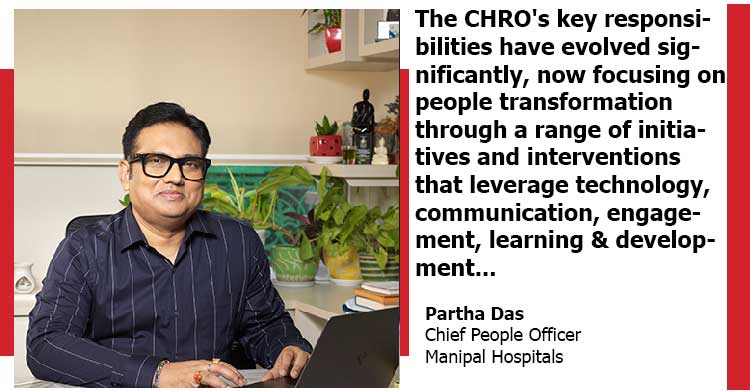How CHROs are rapidly transforming the future of work | Partha Das | Chief People Officer | Manipal Hospitals

The last 5–10 years have seen a remarkable transformation in the HR landscape. HR has finally earned its seat at the table—and the CHRO has taken the driver’s seat. The CHRO’s key responsibilities have evolved significantly, now focusing on people transformation through a range of initiatives and interventions that leverage technology, communication, engagement, learning & development, and overall culture building.
Today, the CHRO’s KRAs are more closely aligned than ever with those of the CEO, especially when it comes to strategic people management. The CHRO strikes an essential balance between addressing human capital needs and harnessing technology to elevate the organizational culture. They are actively integrating AI-driven strategies, upskilling efforts, and organizational development initiatives to boost overall efficiency and impact.
For any organization to succeed in the marketplace, it must focus on strategy, structure, processes, and equally in its human resources. It’s the people who make all the difference. The days when HR professionals were limited to transactional roles are long gone. With the rise of HR business partnering, HR now works closely with stakeholders to drive organizational goals through effective people policies and strategic management.
Organizational development interventions now sit high on the priority list. Today, the CHRO serves as a key advisor, shaping the roadmap to organizational success by driving upskilling initiatives across all levels. To be effective, a CHRO must have a robust, dynamic, and customized talent management framework in place—one that evolves with the needs of the business and its people.
Let’s discuss about some of the meaningful HR interventions:
1. Training Effectiveness Over Volume
It’s not about how many L&D workshops are conducted in a month or year, or how many employees attend them. What truly matters are training effectiveness from the organization’s perspective. The real question is: how well are employees upskilling, and more importantly, how are they translating that learning into action?
2. Strategic HR Interventions and Business Partnering
HR Business Partnering is emerging as a game-changer, enabling HR professionals to collaborate closely with stakeholders on key people-related issues. This partnership underscores the strong correlation between people and performance.
Key Result Areas (KRAs) are increasingly being replaced by Objectives & Key Results (OKRs), which are more strategic and ambitious in nature. In parallel, continuous performance management is taking the place of outdated annual reviews—helping eliminate bias and recency effects. Real-time performance analytics now support the creation of personalized development plans.
Leadership Development & Succession Planning is another critical area. CHROs must focus on developing internal talent and building strong succession pipelines for elevated roles. There’s a clear advantage in nurturing talent from within—it ensures continuity, boosts morale, and strengthens organizational culture.
Given the growing talent scarcity, it’s essential to implement scientific and structured processes for talent development. A balanced approach that combines AI capabilities with cognitive, human-centered strategies is the way forward.
3. Role of AI in HR Transformation
AI adoption is undoubtedly the hot topic of the moment—widely discussed and often debated. While it has helped eliminate many transactional HR tasks, allowing professionals to focus on more strategic areas, there remains a noticeable lack of emotional intelligence in many AI-driven applications, such as job interviews and training programs. So far, there’s no empirical evidence suggesting that AI can replace developmental functions like L&D and OD. For instance, routine tasks like query management are handled efficiently by chatbots, but the human touch remains irreplaceable in areas requiring deeper engagement and development.
If we look at AI’s approach for hiring, it may be used for screening for volume hiring but for the senior-level positions there are chances of missing out the finer points while screening. Similarly, the AI-powered interviews may not be trusted fully, as there is no intelligence involved while screening. The interviews are done very mechanically devoid of the logical evaluation. The competencies of an individual may not be judged in an AI-powered interview.
CHROs are also increasingly leveraging AI to enhance overall efficiency, improve decision-making, and elevate the employee experience. Key focus areas include AI for Employee Engagement & Retention. Sentiment analysis tools can monitor employee well-being and engagement in real-time, using data derived from surveys and internal feedback mechanisms.
4. HR Automation and Predictive Insights
Two other crucial components driving HR transformation are HR Automation and HR Analytics. These bring greater efficiency and offer a competitive edge. Through Workforce Analytics and Predictive HR, AI-driven insights help CHROs anticipate skill gaps, enhance workforce planning, reduce attrition, and retain top talent.
Automation in HR operations is also making a significant impact. AI-powered chatbots now handle routine queries, easing the burden on HR teams. Robotic Process Automation (RPA) is streamlining functions like payroll, compliance, and onboarding. In Learning & Development, automation helps track both learning progress and real-world application—ultimately boosting organizational performance.
5. The Impact of Instant AI Tools on Behaviour
The use of tools like ChatGPT has significantly simplified life for the average person. Instant solutions to everyday queries are now just a click away. While this represents a major leap in accessibility and self-learning compared to the past, there’s a downside- people have become increasingly dependent and, at times, complacent. With information readily available, the motivation to read deeply or make sustained efforts has diminished.
CHROs and HR professionals must harness AI tools thoughtfully and strategically to fully realize their benefits. While AI offers immense potential, it also comes with certain limitations. One of the most critical responsibilities for CHROs today is to guide people transformation—ensuring employees not only adapt to change but also develop a strong business understanding to perform more effectively.
The CHRO role has evolved multifold into a strategic business function. It now demands continuous innovation to stay ahead of the curve. While benchmarking has its place, true competitive advantage lies in thinking differently and acting boldly. In the context of mergers and acquisitions (M&A), the CHRO must adopt a fresh perspective – wearing a different hat and viewing situations through a new lens- especially when cultural alignment is critical.
Today’s CHRO engages with a highly diverse workforce, including the emerging Gen Z generation, making it clear that a one-size-fits-all approach no longer works. This role calls for constant reflection and reinvention. The silver lining? The CHRO plays a pivotal role in driving organizational transformation through people development. With each passing day, the role becomes more dynamic, intriguing, adventurous, and challenging.


